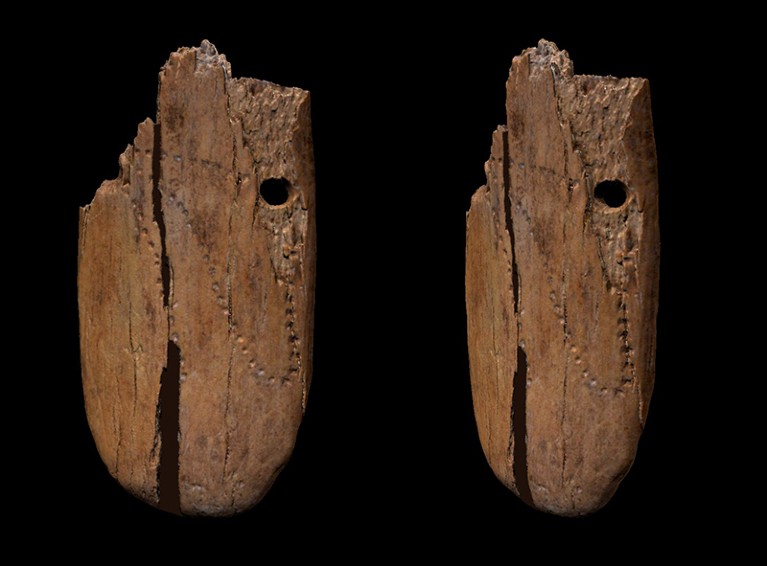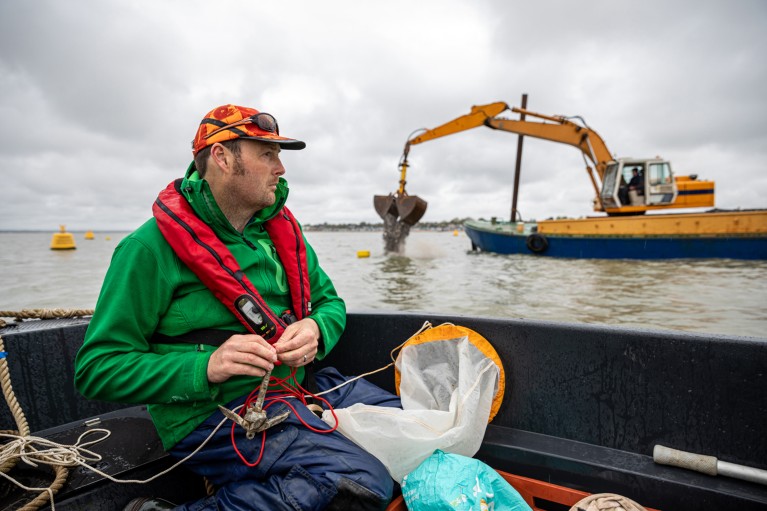Hello Nature readers, would you like to get this Briefing in your inbox free every day? Sign up here.

The pendant, seen here from two different angles, features drilled holes and around 50 smaller indentations that create an irregular curve.Credit: Antonino Vazzana/BONES Lab
Eurasia’s oldest piece of jewellery?
A 41,500-year-old pendant carved from a piece of a woolly mammoth tusk could be the oldest known example of decorated jewellery in Eurasia made by humans. The purpose and meaning of the designs on its surface are unclear, but they could represent a counting system, lunar observations or a way of scoring kills. The pendant was found in the Stajnia Cave, in Poland, alongside a 7-centimetre-long awl — a pointed tool used for making holes — shaped from a piece of horse bone.
Reference: Scientific Reports paper
Data incoming from China’s Mars missions
Data collected by the Tianwen-1 mission and Zhurong Mars rover are offering insight into a previously unexplored region of Mars’s northern hemisphere. More than 30 scientists across mainland China, Hong Kong and Macau who were directly involved with the mission have access to the nearly 200 gigabytes of data collected by China’s Mars explorers. Two publications have already emerged and researchers say more are coming, offering insight into climate, geology and history.
Reference: Research Square preprint & Remote Sensing paper
World’s first living robots can reproduce
The world’s first living robots, created from frog cells, self-replicate by pushing loose cells together. The Pac-Man-shaped blobs are made up of stem cells removed from frog embryos, which naturally cohere and develop hair-like protuberances called cilia. In a dish, they can move around and push loose stem cells into piles with their ‘mouths’. These piles can then develop into ciliated ‘offspring’, and go on to build their own pile-of-stem-cell babies. These are the first multicellular organisms found to reproduce in this way, say the study’s authors. “Most people think of robots as made of metals and ceramics but it’s not so much what a robot is made from but what it does, which is act on its own on behalf of people,” says roboticist and lead author Josh Bongard. “In that way it’s a robot but it’s also clearly an organism made from genetically unmodified frog cells.”
Features & opinion
Put science at the heart of US government
The United States should establish a central government department that oversees science and technology to tackle the demands brought by crises such as pandemics and climate change, argue two former directors of the National Institutes of Health. The country’s current distributed federal research-funding system has fostered US leadership in discovery and should not change, say Harold Varmus and Elias Zerhouni. But a cabinet-level department similar to China’s Ministry of Science and Technology or the European Union’s Horizon Europe research programme would provide a much-needed venue for planning long-term science policies and for developing broadly useful technologies.
Discrimination still plagues science
A Nature survey has found that just under one-third of respondents have witnessed discrimination against or harassment of colleagues in their current job, and 27% said they had personally experienced discrimination, bullying or harassment. Workers in academia who responded to the survey were twice as likely as those in industry to report these experiences. A woman who is now a staff scientist at a US biomedical company wrote of her experience in academia: “I was bullied and harassed repeatedly at my previous job, and literally nothing there has changed or will ever change. My current job is much nicer, but I will never ever work in an academic setting again.”
Laszlo Bito: ‘A man of uncommon courage’
Ocular physiologist Laszo Bito, who discovered the glaucoma treatment latanoprost, has died aged 87. Born in Hungary, Bito was a slave labourer in a coal mine under the Soviet-backed dictatorship, until he escaped and sought asylum in the United States. He used the fortune he made from his discovery to finance a second career as a writer, and to oppose the authoritarian policies of Hungary’s current government, headed by Prime Minister Viktor Orbán. “There’s a good American phrase, ‘Put your money where your mouth is’,” said Bito in 2015. “You can’t just talk. You need to help. And this is the right time for that.”
The New York Times | 7 min read
Read more: Hungarian government takes control of research institutes despite outcry (Nature | 3 min read, from 2019)
Where I work

Tom Cameron is a senior lecturer in ecology at the University of Essex, Colchester, UK.Credit: Jessica Hallett/Nature
Ecologist Tom Cameron works with local oyster growers to restore native oysters to their natural habitat in the United Kingdom. “Amazingly, these filter feeders don’t require feeding by humans, and they clean the water as they grow,” says Cameron. “We’ve done some cool things, including creating one of the largest coastal marine conservation zones in the United Kingdom — more than 284 square kilometres — and all for an unseen brown invertebrate that lacks the charisma of a dolphin.” (Nature | 3 min read)
See more shots from this story on the Nature Instagram account. (Jessica Hallett/Nature)
